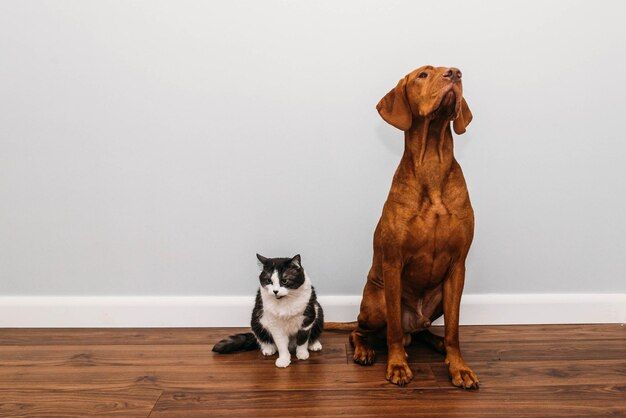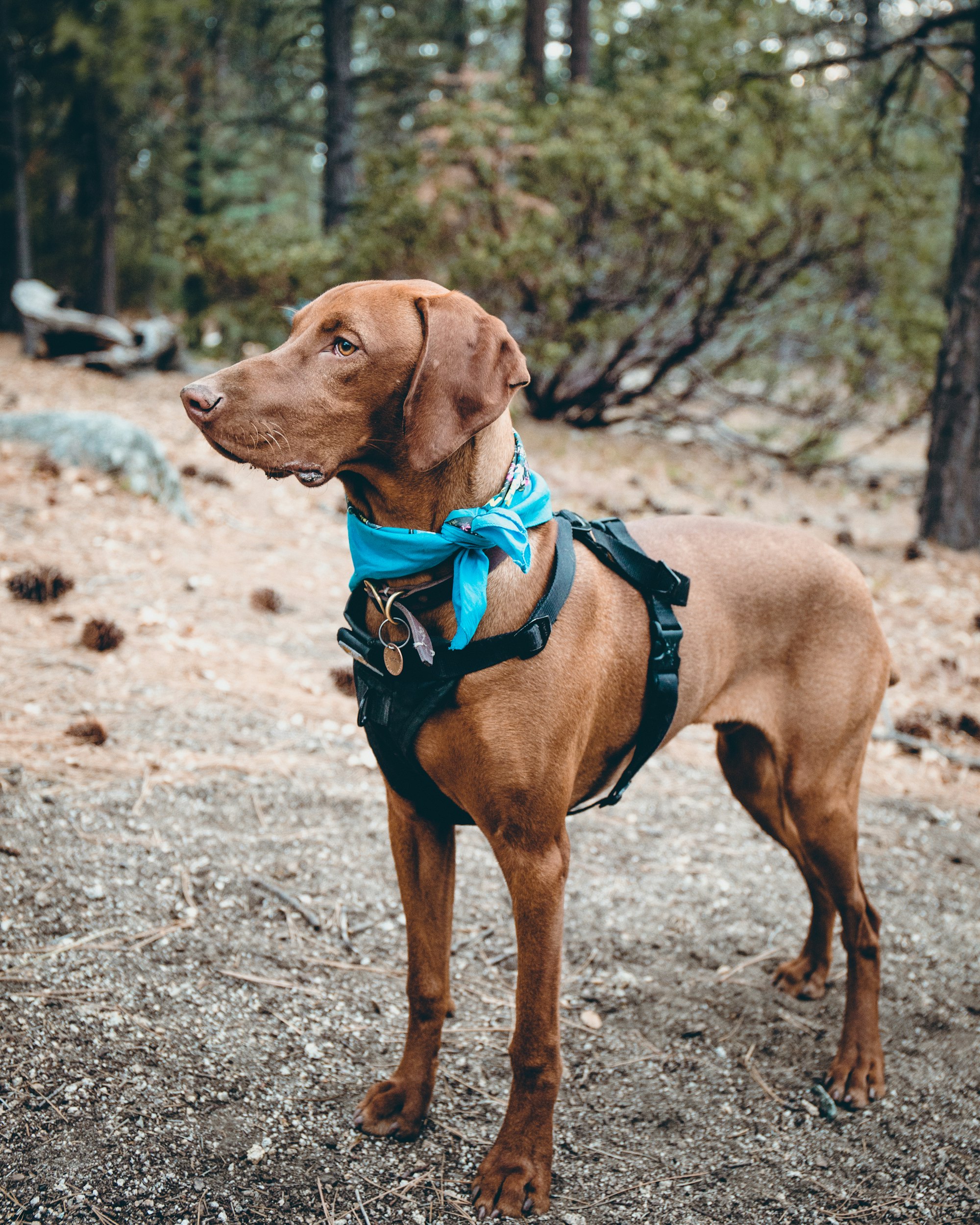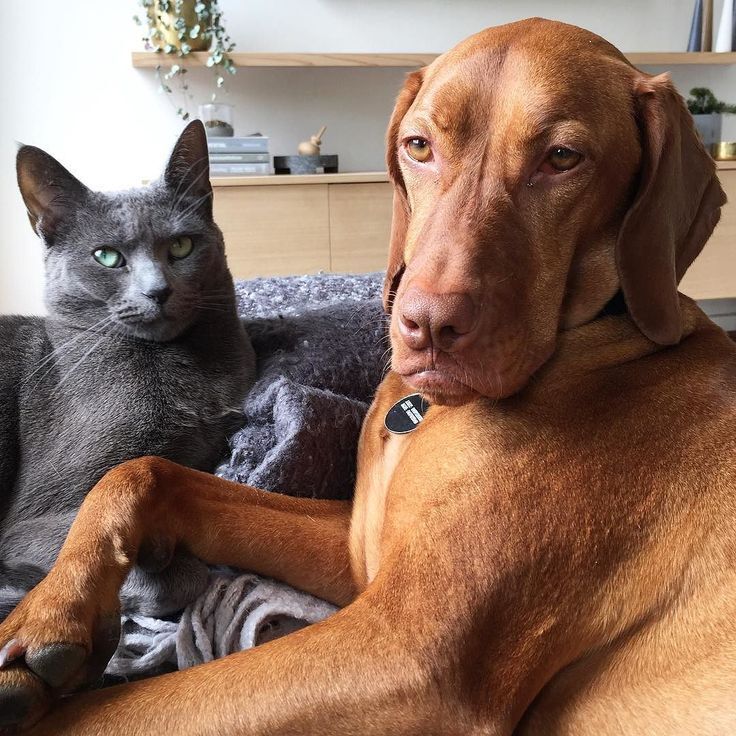Ever stumbled upon a picturesque scene of a sleek, russet-colored Vizsla snuggling up to a majestic feline? It's a sight to behold, but it also raises the million-dollar question: Are Vizslas good with cats?
You're in luck! Today, we dive deep, decoding this enigma and offering expert insights on the compatibility between Vizslas and cats. Buckle up!

The Origin Tales
To understand the Vizsla-cat dynamics, it's crucial to journey back to the origins of the Vizsla breed. Vizslas, often called the "Hungarian Pointer", hail from Hungary. Historically, they were bred as hunting dogs, possessing an acute sense of smell and an unmatched zeal for chasing game. This might initially raise eyebrows concerning the Vizsla and cat compatibility. But remember, every story has two sides.
Vizsla Temperament: More than Meets the Eye
It's easy to pigeonhole Vizslas solely as hunting dogs. But beyond their hunting prowess, they're incredibly affectionate, loyal, and gentle creatures. Vizslas form strong attachments to their families, often referred to as "Velcro dogs" because of their tendency to stick close to their owners.
These characteristics can be a double-edged sword when introducing a cat into the mix. On one hand, a well-socialized Vizsla, used to cohabiting with various animals, can accept and even bond with a cat. On the other hand, their hunting instinct may kick in, leading to some initial chasing. Remember, this doesn't inherently mean aggression but is often a game to them.
Cats and Dogs Cohabiting: The Age-Old Narrative
Cats and dogs – the world often paints them as arch-nemeses. But countless households stand as testament to harmonious cat-dog cohabiting. The secret? Early introduction and understanding each animal's unique disposition.
In the realm of Vizsla breed characteristics, their adaptability shines through. If introduced to cats during their puppy years, Vizslas often grow up viewing cats as part of their pack. Cats, being territorial creatures, usually set the rules in these relationships. Over time, with mutual respect and boundaries, a Vizsla and a cat can share a peaceful, and often affectionate, bond.
Expert Tips on Vizsla-Cat Interactions
Training Vizslas with Cats: Starting Right
Early introduction is vital. The younger the Vizsla, the more malleable its behavior. Use positive reinforcement when the dog behaves appropriately around the cat, discouraging chasing or overly boisterous play.
Safe Spaces and Supervision
Always supervise initial interactions. Cats should have a safe space they can retreat to, ensuring they don't feel threatened. Over time, as trust develops, supervision can decrease, but the safe spaces should always remain.
Understand the Signals
Educate yourself on both Vizsla and cat body language. A Vizsla wagging its tail might signify excitement, while a cat with a puffed tail indicates fear or agitation. Recognizing these cues can preempt potential issues.
Delving Deeper: The Feline Perspective
While we've dived deep into the Vizsla psyche, it's essential to also consider our feline friends. Cats, unlike most dogs, are territorial creatures. They lay claim to spaces, and any newcomer, be it a human, another cat, or a dog, might be seen as an intruder.
Feline First Impressions
Cats are notorious for their first impressions. Introducing a Vizsla to a feline domain requires tactics. Begin by letting them sniff each other's items — a toy, bed, or blanket. This scent exchange can create a familiarization before they physically meet.
Slow and Steady
Rapid introductions are a recipe for disaster. After the scent swap, consider gated introductions. A baby gate works wonders here, allowing them to see, smell, and observe each other without physical contact.
Vizsla-Cat Bonds: Beyond the Basics
While initial introductions and training are crucial, fostering a long-term bond between Vizslas and cats is an ongoing process.
Activities Together
Engaging them in mutual activities can boost their relationship. Perhaps it's a playful session with a toy or a joint outdoor expedition (with the cat in a harness, of course). Shared positive experiences can fortify their bond.
Health Check-ins
Regular vet check-ins ensure that both pets are in optimal health. A sick or irritable animal is less likely to socialize well. Keeping them in top shape can contribute to smoother interactions.

The Ultimate Takeaway
The camaraderie between Vizslas and cats isn't just a possibility; it's a reality for many. With understanding, patience, and a dash of expert insights, these two seemingly disparate species can coexist, thrive, and even love each other deeply.
So, as you ponder the age-old debate, remember: when guided by love and understanding, interspecies friendships aren't just likely — they're inevitable. Here's to more Vizslas cuddling with cats, challenging stereotypes, and warming hearts worldwide!
The Science Behind Vizsla and Cat Interactions
When considering the dynamic between Vizslas and cats, it's vital to dive deep into the scientific and behavioral aspects of their relationship. How do evolutionary origins, communication patterns, and environmental factors play a role in their coexistence?
Evolutionary Patterns: Pack vs. Solitary
Both cats and dogs have evolved distinctively based on their hunting patterns and survival mechanisms. Cats, as solitary hunters, tend to be territorial and independent. This is in stark contrast to dogs like Vizslas, descendants of pack animals, who have an innate understanding of social structures and relationships.
When a social creature like a Vizsla encounters a territorial one like a cat, their interactions are influenced by their evolutionary histories. But with understanding and guidance, these two worlds can harmoniously intertwine.
Deciphering Communication Cues
Vizslas and cats have distinct "languages" when it comes to communication. A wagging tail in a Vizsla often signifies happiness, while a similar movement in a cat might indicate irritation or anxiety.
For successful cohabitation, it becomes imperative for pet owners to understand and interpret these cues correctly. By doing so, they can preempt potential issues and foster understanding between the two animals.
Interestingly, over prolonged coexistence, Vizslas and cats often develop a unique communication system. It's not uncommon for Vizslas to pick up cat-like behaviors and vice-versa.

Crafting Cohabitation: Environmental Considerations
Beyond understanding, the environment plays a pivotal role in ensuring a peaceful coexistence between Vizslas and cats.
Separate But Equal
Maintaining distinct zones for both animals, especially during feeding, can help avoid potential flashpoints. While Vizslas are social and might not mind sharing, cats value their independence and can become agitated if they feel their space is being invaded.
Harmonious Playtime
Establishing boundaries during playtime is equally important. Given the Vizsla's high energy levels, they might inadvertently overwhelm a cat during play. Using toys that cater to both or setting up separate play sessions can ensure that both get the exercise and entertainment they need without any stress.
Bridging The Gap: Training and Patience
The key to a harmonious relationship between Vizslas and cats lies in effective training and an abundance of patience. Early introduction, positive reinforcement, and consistent monitoring can go a long way in ensuring a peaceful environment. Over time, as mutual trust and understanding develop, Vizslas and cats can form a bond that's both endearing and strong.
Behavioral Conditioning: The Golden Key
The journey to ensuring a peaceful coexistence between Vizslas and cats often starts with behavioral conditioning. By introducing the two species during their formative years, the chances of a harmonious relationship significantly increase.
Reward-based Systems
When a Vizsla acts calmly around a cat, rewarding them with treats or praise creates positive associations. Over time, this can lead the Vizsla to understand that good behavior around the cat is beneficial. Similarly, when a cat remains calm or indifferent around a Vizsla, offering them their favorite treat can reinforce this behavior.
Consistent Ground Rules
Setting consistent rules is essential. If the Vizsla is not allowed to play with the cat's toys, this rule must be enforced always to avoid confusion. Similarly, cats should have designated areas where they can retreat without being disturbed. Consistency provides a sense of security and predictability for both animals.
Environmental Enrichment: A Shared Haven
An environment that caters to the needs of both Vizslas and cats can be a game-changer. Here's how:
Vertical Spaces
Cats love vertical spaces. Providing shelves, cat trees, or elevated resting places can give cats a sense of security, allowing them to observe the Vizsla from a safe distance.
Interactive Toys
Toys that cater to the hunting instincts of both Vizslas and cats can offer mutual entertainment. Think laser toys or puzzle feeders. They can be used to engage both animals, often diverting potential confrontations and channeling energy into play.

The Health Factor: Preventing Potential Issues
Regular health check-ups are paramount. A Vizsla or cat that's unwell might become irritable, leading to increased chances of confrontations. Regular vet visits ensure both animals remain in optimal health, promoting smoother interactions.
Nutrition Matters
A balanced diet plays a pivotal role in behavior. Ensuring that both Vizslas and cats get the right nutrition can prevent mood swings and keep them satiated, reducing the chances of food-related skirmishes.
Understanding Individual Personalities
While we often generalize breed characteristics, it's pivotal to remember that each Vizsla and cat comes with their unique personality. Just as humans differ in temperament, so do our furry companions.
Observing Interactions
Being a keen observer can provide invaluable insights. Some Vizslas might be more docile or cat-friendly, while others could have a stronger prey drive. Similarly, some cats are more dog-tolerant, while others might be more skittish or territorial. Recognizing these individual traits can guide interactions and training strategies.
Adjusting Expectations
It's essential to have realistic expectations. Not every Vizsla will become best friends with a cat, and vice-versa. The goal should be peaceful coexistence, and any additional bond or affection is a bonus.
Continuous Learning and Adaptation
As both animals age and go through different life stages, their behavior and tolerance levels might change. Being adaptable and open to modifying strategies ensures long-term harmony.
Senior Pets and New Challenges
Aging can bring about health issues or changes in behavior. A once energetic Vizsla might become less tolerant due to joint pain or declining vision. On the flip side, an older cat might become more susceptible to stress or disturbances. Being cognizant of these changes and making necessary adjustments in their shared environment can mitigate potential conflicts.
Education and External Resources
Staying informed and seeking external resources or expert advice can be beneficial. Whether it's attending workshops, reading books, or consulting with animal behaviorists, continuous learning can offer new perspectives and solutions.
Celebrating the Small Wins
Every positive interaction, be it a shared nap or a playful session without any hissing or growling, is a win. Celebrating these moments encourages a positive atmosphere and reinforces the efforts put into fostering this unique bond.
Beyond the Home: Social Integration and External Factors
Taking the Vizsla-cat relationship outside the confines of the home introduces another layer of considerations. External stimuli can have a significant impact on how both animals perceive and interact with each other.
Social Experiences and Impact
Imagine a scenario where a Vizsla has a negative encounter with another animal outside. This event might temporarily alter its behavior with the resident cat. Being aware of these experiences and their potential impact is vital for preempting any unwarranted change in their in-house dynamics.
Environmental Stimuli
A sudden change in environment, like moving to a new house, can disrupt established territories and comfort zones for both Vizslas and cats. During these transitions, it's essential to monitor their interactions closely, providing extra care to ensure both feel secure in the new setting.
Embracing Technology: Digital Aids
In today's tech-savvy world, numerous apps and gadgets can assist in understanding and enhancing the bond between Vizslas and cats.
Monitoring Devices
Using pet cameras or motion-activated sensors can provide insights into their behavior when you're not around. This can be particularly useful to understand any unsupervised interactions and adjust strategies accordingly.
Interactive Toys
Technological advancements have led to the development of interactive toys that can engage both species. Devices that release treats upon solving a puzzle or toys that stimulate hunting instincts can be shared enjoyment sources and provide mental stimulation.

Community and Shared Experiences
Engaging with online communities, forums, or local pet groups can be invaluable. Hearing from others who've walked the same path, sharing experiences, challenges, and solutions can offer fresh perspectives and support.
Workshops and Training Sessions
Many animal experts and trainers conduct workshops focusing on interspecies cohabitation. Attending these can equip you with tools, techniques, and insights to further enhance the bond between your Vizsla and cat.
Beyond the Home: Social Integration, External Factors, and FI Dog Collars
Taking the Vizsla-cat relationship outside the home introduces another layer of considerations. External stimuli, especially for the Vizsla, can significantly impact their behavior. Here's where the FI dog collar steps in as an invaluable tool.
Social Experiences and the Role of FI Dog Collars
Imagine a scenario where a Vizsla, equipped with an FI dog collar, ventures outside and has a negative encounter with another animal. The real-time tracking and activity monitoring feature of the collar can alert you to any abrupt changes in the Vizsla's movement or behavior, allowing for timely intervention and understanding potential impacts on their behavior with the resident cat.
Environmental Stimuli and FI's Safety Features
Moving to a new environment or even everyday outdoor exploration can introduce numerous unknown factors. The FI dog collar, with its GPS tracking, ensures that even if your Vizsla wanders off, they're always within reach. This added layer of security can be especially crucial in new surroundings, ensuring both the Vizsla and cat maintain their harmonious relationship without external stressors.
Conclusion:
In understanding the harmonious coexistence of Vizslas and cats, numerous facets come into play — from evolutionary patterns, environmental adjustments, and behavioral conditioning to embracing technological aids like the FI dog collar. This collar, with its real-time tracking and activity monitoring, revolutionizes pet safety and understanding, adding an invaluable dimension to multi-pet households. By combining insights from both nature and technology, we pave the way for a future where Vizslas and cats not only cohabit peacefully but thrive together. It's a testament to the endless possibilities of interspecies bonds, underscored by human innovation and understanding.
Frequently Asked Questions (FAQs)
- Are Vizslas naturally good with cats?
- Vizslas, known for their affectionate nature, can coexist harmoniously with cats, especially when introduced at a young age. However, their hunting instincts may sometimes come into play, requiring monitoring and training for a peaceful relationship.
- How can the FI dog collar benefit Vizsla and cat households?
- The FI dog collar offers real-time tracking and activity monitoring. It provides an added layer of security for Vizslas, ensuring they're always within reach, which indirectly ensures a stress-free environment for the resident cat.
- How important is early introduction in Vizsla-cat relationships?
- Early introduction is vital. Introducing a Vizsla to a cat during their formative years often results in better acceptance, understanding, and coexistence between the two.
- How can technology, like the FI dog collar, aid in understanding pet behaviors?
- The FI dog collar provides insights into a Vizsla's activity levels, health, and patterns. This data can guide pet owners in planning interactions, ensuring both the cat and Vizsla lead balanced and enriched lives.
- What are some tips for a harmonious relationship between Vizslas and cats?
- Effective training, consistent ground rules, reward-based systems, separate feeding zones, and understanding individual personalities play key roles in fostering a peaceful Vizsla-cat relationship.
- Can Vizslas and cats communicate effectively despite their distinct languages?
- While Vizslas and cats have different communication cues, with time and observation, they often develop a unique communication system, understanding each other's signals and behaviors.
- How does the community of FI dog collar users benefit multi-pet households?
- Engaging with the FI dog collar community provides insights, shared experiences, and solutions, assisting owners in navigating the challenges and joys of multi-pet households, particularly those with Vizslas and cats.
- Are there any environmental considerations for Vizsla-cat cohabitation?
- Yes, creating separate but equal zones, especially during feeding, and providing vertical spaces for cats can ensure a peaceful environment for both Vizslas and cats.
- How does the FI dog collar enhance safety during environmental transitions?
- The FI dog collar, with its GPS tracking, ensures Vizslas are always traceable, particularly important during changes like moving homes, ensuring reduced stress for both the Vizsla and the resident cat.
- Can Vizslas and cats truly form deep bonds?
- Absolutely! With understanding, patience, and the right strategies, Vizslas and cats can form bonds that are both affectionate and deeply enriching for both animals.




